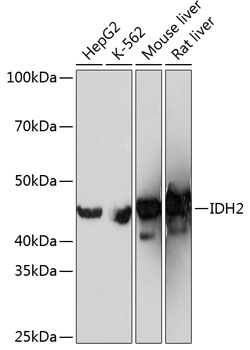Metabolism Antibodies 3
Anti-IDH2 Antibody (CAB11270)
- SKU:
- CAB11270
- Product Type:
- Antibody
- Reactivity:
- Human
- Reactivity:
- Mouse
- Reactivity:
- Rat
- Host Species:
- Rabbit
- Isotype:
- IgG
- Antibody Type:
- Monoclonal Antibody
- Research Area:
- Metabolism
Description
| Antibody Name: | Anti-IDH2 Antibody |
| Antibody SKU: | CAB11270 |
| Antibody Size: | 20uL, 50uL, 100uL |
| Application: | WB IHC IF |
| Reactivity: | Human, Mouse, Rat |
| Host Species: | Rabbit |
| Immunogen: | A synthesized peptide derived from human IDH2 |
| Application: | WB IHC IF |
| Recommended Dilution: | WB 1:500 - 1:2000 IHC 1:50 - 1:200 IF 1:50 - 1:200 |
| Reactivity: | Human, Mouse, Rat |
| Positive Samples: | HepG2, K-562, Mouse liver, Rat liver |
| Immunogen: | A synthesized peptide derived from human IDH2 |
| Purification Method: | Affinity purification |
| Storage Buffer: | Store at -20°C. Avoid freeze / thaw cycles. Buffer: PBS with 0.02% sodium azide, 0.05% BSA, 50% glycerol, pH7.3. |
| Isotype: | IgG |
| Sequence: | Email for sequence |
| Gene ID: | 3418 |
| Uniprot: | P48735 |
| Cellular Location: | |
| Calculated MW: | 45kDa |
| Observed MW: | 43KDa |
| Synonyms: | D2HGA2, ICD-M, IDH, IDHM, IDP, IDPM, mNADP-IDH |
| Background: | Isocitrate dehydrogenases catalyze the oxidative decarboxylation of isocitrate to 2-oxoglutarate. These enzymes belong to two distinct subclasses, one of which utilizes NAD(+) as the electron acceptor and the other NADP(+). Five isocitrate dehydrogenases have been reported: three NAD(+)-dependent isocitrate dehydrogenases, which localize to the mitochondrial matrix, and two NADP(+)-dependent isocitrate dehydrogenases, one of which is mitochondrial and the other predominantly cytosolic. Each NADP(+)-dependent isozyme is a homodimer. The protein encoded by this gene is the NADP(+)-dependent isocitrate dehydrogenase found in the mitochondria. It plays a role in intermediary metabolism and energy production. This protein may tightly associate or interact with the pyruvate dehydrogenase complex. Alternative splicing results in multiple transcript variants. [provided by RefSeq, Feb 2014] |
| UniProt Protein Function: | IDH2: a mitochondrial oxidoreductase that catalyzes the third step of the citric acid cycle: the oxidative decarboxylation of isocitrate, consuming NADP(+), and producing alpha-ketoglutarate (alpha-KG) and CO2. Can also use oxalosuccinate as a substrate. Alpha-KG is an activator the dioxygenases that hydroxylate the transcription factor HIF and lead to its degradation by VHL. Since HIF turns on oncogenic pathways, IDH2 has apparent tumor suppressor activity. Homo-dimerization is required for activity. Each subunit binds 1 magnesium or manganese ion. May tightly associate or interact with the pyruvate dehydrogenase complex. A somatic mutation resulting in the R172K conversion results in a neomorphic enzyme activity that converts isocitrate to R(-)-2-hydroxyglutarate (2HG) occurs in a significant percentage of patients with cytogenetically normal acute myeloid leukemia (AML). Elevated levels of 2HG are also correlated with an elevated risk of malignant brain tumors. |
| UniProt Protein Details: | Protein type:Mitochondrial; Carbohydrate Metabolism - citrate (TCA) cycle; EC 1.1.1.42; Other Amino Acids Metabolism - glutathione; Oxidoreductase Chromosomal Location of Human Ortholog: 15q26.1 Cellular Component: mitochondrion; mitochondrial matrix; mitochondrial inner membrane Molecular Function:magnesium ion binding; isocitrate dehydrogenase (NADP+) activity; NAD binding Biological Process: glyoxylate cycle; isocitrate metabolic process; cellular metabolic process; tricarboxylic acid cycle; carbohydrate metabolic process; 2-oxoglutarate metabolic process Disease: D-2-hydroxyglutaric Aciduria 2 |
| NCBI Summary: | Isocitrate dehydrogenases catalyze the oxidative decarboxylation of isocitrate to 2-oxoglutarate. These enzymes belong to two distinct subclasses, one of which utilizes NAD(+) as the electron acceptor and the other NADP(+). Five isocitrate dehydrogenases have been reported: three NAD(+)-dependent isocitrate dehydrogenases, which localize to the mitochondrial matrix, and two NADP(+)-dependent isocitrate dehydrogenases, one of which is mitochondrial and the other predominantly cytosolic. Each NADP(+)-dependent isozyme is a homodimer. The protein encoded by this gene is the NADP(+)-dependent isocitrate dehydrogenase found in the mitochondria. It plays a role in intermediary metabolism and energy production. This protein may tightly associate or interact with the pyruvate dehydrogenase complex. Alternative splicing results in multiple transcript variants. [provided by RefSeq, Feb 2014] |
| UniProt Code: | P48735 |
| NCBI GenInfo Identifier: | 20141568 |
| NCBI Gene ID: | 3418 |
| NCBI Accession: | P48735.2 |
| UniProt Secondary Accession: | P48735,Q96GT3, B2R6L6, B4DFL2, |
| UniProt Related Accession: | P48735 |
| Molecular Weight: | 452 |
| NCBI Full Name: | Isocitrate dehydrogenase |
| NCBI Synonym Full Names: | isocitrate dehydrogenase 2 (NADP+), mitochondrial |
| NCBI Official Symbol: | IDH2 |
| NCBI Official Synonym Symbols: | IDH; IDP; IDHM; IDPM; ICD-M; D2HGA2; mNADP-IDH |
| NCBI Protein Information: | isocitrate dehydrogenase [NADP], mitochondrial; isocitrate dehydrogenase [NADP], mitochondrial; NADP(+)-specific ICDH; oxalosuccinate decarboxylase |
| UniProt Protein Name: | Isocitrate dehydrogenase [NADP], mitochondrial |
| UniProt Synonym Protein Names: | ICD-M; IDP; NADP(+)-specific ICDH; Oxalosuccinate decarboxylase |
| Protein Family: | Isocitrate dehydrogenase |
| UniProt Gene Name: | IDH2 |
| UniProt Entry Name: | IDHP_HUMAN |







